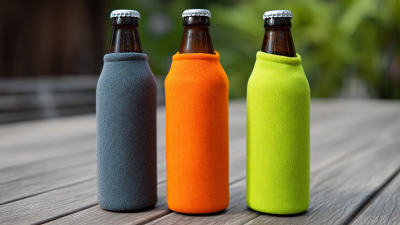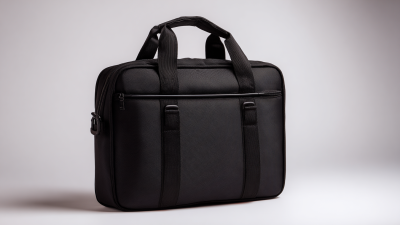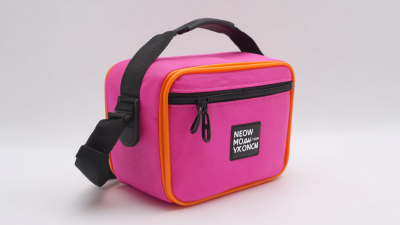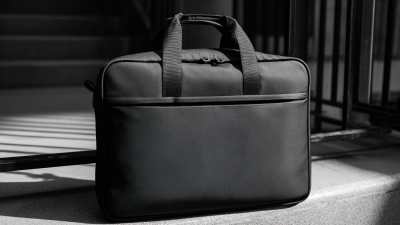The demand for effective beverage cooling solutions has led to the widespread use of Neoprene Can Coolers, a popular choice among consumers for their superior insulation properties. According to a recent market research report by Grand View Research, the global beverage cooler market is projected to reach USD 1.21 billion by 2025, with a significant portion attributed to innovations such as Neoprene Can Coolers. These products not only provide thermal insulation, maintaining optimal beverage temperatures for extended periods, but they also offer a lightweight and portable design suitable for a variety of settings, from outdoor adventures to casual gatherings. As environmental awareness rises, manufacturers of Neoprene Can Coolers are increasingly focusing on sustainability, with advancements in eco-friendly materials and processes. This article delves into the science behind Neoprene Can Coolers, exploring how their unique construction contributes to their effectiveness in keeping beverages chilled and the overall impact on consumer choices in the market.

Neoprene can coolers have become a popular accessory for keeping beverages chilled, thanks in significant part to the material’s exceptional thermal insulation properties. Neoprene is a synthetic rubber known for its closed-cell structure, which provides excellent barrier characteristics against heat transfer. According to a 2021 report from the International Thermal Insulation Association, materials like neoprene can reduce heat flow by up to 95%, significantly outperforming traditional materials such as foam.
The thermal efficiency of neoprene is attributed to its ability to trap air within its cellular structure. This trapped air acts as an insulating layer that minimizes thermal conduction, thus slowing the transfer of heat from the external environment to the chilled beverage. Additionally, research published by Material Research Society indicates that neoprene can maintain a beverage’s temperature for hours, allowing consumers to enjoy their drinks without the rapid warming that typically occurs with exposure to external temperatures. This is particularly beneficial in outdoor settings or during summer events where maintaining the desired temperature is essential for refreshment.
| Property | Description | Value |
|---|---|---|
| Thermal Conductivity | Measure of a material's ability to conduct heat | 0.13 W/mK |
| Density | Mass per unit volume of neoprene | 0.12 g/cm³ |
| Thickness | Standard thickness for effective insulation | 5 mm |
| Temperature Retention | Duration beverage stays cold | Up to 3 hours |
| Water Resistance | Ability to repel water and withstand moisture | High |
| Flexibility | Ability to bend and return to original shape | Excellent |
Neoprene can coolers have gained popularity for their effectiveness in keeping beverages chilled, but how do they compare to other materials like foam or fabric? In a comparative study, neoprene stands out due to its excellent thermal insulation properties. Unlike foam, which can lose its shape and insulating ability over time, neoprene maintains its structure and provides a snug fit around cans or bottles. This snugness not only contributes to better insulation but also minimizes air gaps that could compromise cooling efficiency.
When considering materials for a can cooler, it's essential to look at durability and insulation performance. Neoprene can withstand various environmental factors, making it suitable for outdoor activities. In contrast, fabric coolers, while often more stylish, may not offer the same level of thermal protection. For the best experience, choose a neoprene cooler with double-layer insulation, which can significantly enhance its cooling capability while adding to its longevity.
Tips: Always pre-chill your beverage before using a cooler. This practice ensures that even when placed in the warmer environment, the can or bottle remains cool for longer periods. Additionally, keep your cooler away from direct sunlight to extend its cooling effectiveness.
Neoprene can coolers are popular for their ability to keep beverages cold, but the thickness of the neoprene plays a crucial role in their efficiency. Thicker neoprene provides better insulation, reducing the transfer of heat from the outside environment to the drink inside. This makes a significant difference in temperature retention. For instance, a cooler with 5mm neoprene can keep drinks chilled for several hours longer than one with 2mm thickness, especially in warm temperatures.

When selecting a neoprene can cooler, consider how long you plan to be outdoors and the temperature. If you're at a picnic or an outdoor concert, a thicker cooler can enhance your experience by ensuring your drinks stay cold longer. Additionally, make sure the cooler fits snugly around your can, as gaps can lead to heat absorption.
Tips for maximizing the effectiveness of your neoprene cooler include pre-chilling your beverages in a refrigerator or cooler before putting them in the sleeve. Moreover, avoid exposing the cooler to direct sunlight for extended periods, as this can increase the heat transfer. By being mindful of the thickness of neoprene and the surrounding conditions, you can extend your drink’s cooling power considerably.
Neoprene can coolers have become essential accessories for outdoor enthusiasts, providing reliable insulation to keep beverages cold during various activities. The science behind neoprene's effectiveness lies in its unique composition, which features closed-cell foam that traps air, creating a barrier against heat transfer. This insulation property not only retains cold temperatures but also offers a layer of protection against external weather conditions. As a result, neoprene can coolers are perfect for picnics, beach trips, and camping, allowing users to enjoy chilled drinks without the hassle of constant ice replenishment.
According to a market analysis report, the neoprene industry is expected to see significant growth, with projections indicating a market size of USD 2,163.6 million by 2033. This growth can be attributed to the increasing demand for versatile outdoor gear that enhances user experience. Similarly, neoprene products like boot covers and vests are finding their place in winter sports and hunting activities. They provide windproof and waterproof protection, making them ideal for both casual outings and intense outdoor adventures. As the trend for outdoor activities continues to rise, the relevance of neoprene in various applications stands out, solidifying its place in the market.

Neoprene products, including can coolers, are increasingly scrutinized for their environmental impact and sustainability. As the demand for eco-friendly alternatives rises, several brands are seeking innovative ways to minimize waste and promote recycling. Reports reveal that the production of natural rubbers, a primary component in many neoprene products, is energy-intensive and has significant water and chemical usage, highlighting the need for more sustainable practices across the industry.
Recycling initiatives are gaining traction, with new projects focused on reducing the environmental footprint of neoprene. For example, the development of wetsuit recycling facilities is a critical step in mitigating the volume of old neoprene heading to landfills. Brands are also exploring sustainable materials like natural rubber, which offers a more eco-friendly alternative to traditional neoprene. It’s essential for manufacturers to commit to such sustainable innovations, as they not only help reduce waste but also resonate with environmentally conscious consumers.
Tips: When choosing neoprene products, look for those made from recycled materials or those that offer recycling programs. Additionally, consider supporting companies that prioritize sustainability in their production processes, as this can drive the industry toward more eco-friendly practices. Always check for certifications that indicate a commitment to environmental responsibility.






